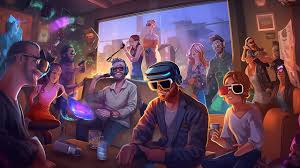Virtual Reality and Social Interaction
Building Communities in Virtual Spaces
Virtual reality (VR) technology has evolved rapidly in recent years, transforming how we interact with digital content and each other. This immersive technology allows users to step into virtual worlds, creating new opportunities for social interaction and community building.
Virtual Reality and Social Interaction: Building Communities in Virtual Spaces
Virtual reality (VR) technology has evolved rapidly in recent years, transforming how we interact with digital content and each other. This immersive technology allows users to step into virtual worlds, creating new opportunities for social interaction and community building.
VR and Social Interaction
VR has the potential to revolutionize social interaction by creating more engaging and immersive experiences. Imagine participating in a virtual concert with friends from around the world, attending a virtual conference, or even having a virtual coffee date. VR headsets allow users to interact with digital environments and avatars in a way that feels more natural and realistic than traditional online platforms.
Benefits of VR for Social Interaction:
- Immersive Experiences: VR creates a sense of presence and immersion that traditional video conferencing or online games cannot match. Users can feel like they are physically present in a shared space, fostering a stronger sense of connection and engagement.
- Enhanced Communication: VR allows for more expressive and nuanced communication. Users can utilize body language, facial expressions, and gestures to convey their emotions and thoughts more effectively.
- Breaking Down Physical Barriers: VR removes physical limitations, enabling people from different locations or with disabilities to connect and interact easily. This opens up new opportunities for social inclusion and community building.
Building Communities in Virtual Spaces
VR has the potential to foster a sense of community among users. By creating shared experiences and fostering meaningful connections, VR platforms can become vibrant virtual hubs where people come together to socialize, collaborate, and support each other.
Examples of VR Communities:
- Social VR Platforms: Platforms like VRChat, AltspaceVR, and Rec Room offer virtual spaces where users can meet, chat, play games, and participate in social activities.
- Virtual Events and Conferences: VR is increasingly being used to host events and conferences, providing a platform for people to connect, network, and learn from each other.
- Shared Interests and Hobbies: VR communities can be built around specific interests and hobbies, such as gaming, fitness, or art. Users can find like-minded individuals to share their passions with.
The development of VR technology continues to evolve, leading to more realistic and engaging experiences. As VR becomes more accessible and widely adopted, we can expect to see even more creative and innovative ways to build communities in virtual spaces.
Summary
- VR technology creates immersive experiences that enhance social interaction and communication.
- VR platforms have the potential to foster a sense of community by providing shared experiences and meaningful connections.
- VR offers opportunities for social inclusion and breaking down physical barriers, connecting people from diverse backgrounds and locations.
